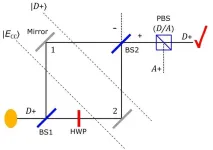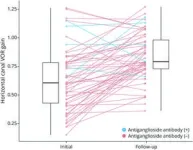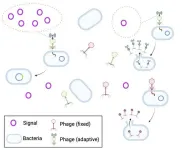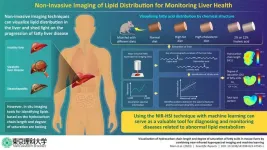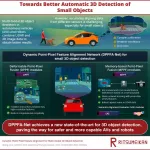(Press-News.org) The quantum Cheshire cat effect draws its name from the fictional Cheshire Cat in the Alice in Wonderland story. That cat was able to disappear, leaving only its grin behind. Similarly, in a 2013 paper, researchers claimed quantum particles are able to separate from their properties, with the properties travelling along paths the particle cannot. They named this the quantum Cheshire cat effect. Researchers since have claimed to extend this further, swapping disembodied properties between particles, disembodying multiple properties simultaneously, and even “separating the wave-particle duality” of a particle.
However, recent research, published in the New Journal of Physics on November 17, 2023, shows that these experiments don’t actually show particles splitting from their properties, but instead display another counterintuitive feature of quantum mechanics — contextuality.
Quantum mechanics is the study of the behavior of light and matter at the atomic and subatomic scale. By its nature, quantum mechanics is counterintuitive. The research team set out to fundamentally understand this counterintuitive nature, while exploring practical benefits.
“Most people know that quantum mechanics is weird, but identifying what causes this weirdness is still an active area of research. It has been slowly formalized into a notion called contextuality — that quantum systems change depending on what measurements you do on them,” said Jonte Hance, a research fellow at Hiroshima University and the University of Bristol.
A sequence of measurements on a quantum system will produce different results depending on the order in which the measurements are done. For instance, if we measure where a particle is, then how fast it is travelling, this will give different results to first measuring how fast it travels, then where it is. Because of this contextuality, quantum systems can be measured as having properties which we would expect to be mutually incompatible. “However, we still don’t really understand what causes this, so this is what we wanted to investigate, using the paradoxical quantum Cheshire cat scenario as a testbed,” said Hance.
The team notes that the problem with the quantum Cheshire cat paradox is that its original claim, that the particle and its property, such as spin or polarization, separate and travel along different paths, may be a misleading representation of the actual physics of the situation. “We want to correct this by showing that different results are obtained if a quantum system is measured in different ways, and that the original interpretation of the quantum Cheshire cat only comes about if you combine the results of these different measurements in a very specific way, and ignore this measurement-related change,” said Holger Hofmann, a professor at Hiroshima University.
The team analyzed the Cheshire cat protocol by examining the relation between three different measurements regarding the path and polarization of a photon within the quantum Cheshire cat protocol. These would have seemed to result in a logical contradiction, were the system not contextual. Their paper discusses how this contextual behavior links to weak values, and the coherences between prohibited states. Through their work, they showed that instead of a property of the particle being disembodied, the quantum Cheshire cat instead demonstrates the effects of these coherences, typically found in pre- and post-selected systems.
Looking ahead the team wants to expand this research, to find a way to unify paradoxical quantum effects as manifestations of contextuality, and to explain once and for all how and why measurements change quantum systems. “This will not only help us finally explain why quantum mechanics is so counterintuitive, but will also help us develop ways to use this weirdness for practical purposes. Given contextuality is inherently linked to scenarios where there is a quantum advantage over classical solutions to a given problem, only by understanding contextuality will we be able to realize the full potential of, for instance, quantum computing,” said Hance.
The research team includes Jonte R. Hance, Ming Ji, and Holger F. Hofmann from the Graduate School of Advanced Science and Engineering, Hiroshima University. Hance is also a research associate in the Department of Electrical and Electronic Engineering at the University of Bristol.
The research was funded by Hiroshima University’s Phoenix Postdoctoral Fellowship for Research, the University of York’s EPSRC DTP grant, the Quantum Communications Hub that is funded by EPSRC grants, and a JST SPRING grant.
###
About Hiroshima University
Since its foundation in 1949, Hiroshima University has striven to become one of the most prominent and comprehensive universities in Japan for the promotion and development of scholarship and education. Consisting of 12 schools for undergraduate level and 4 graduate schools, ranging from natural sciences to humanities and social sciences, the university has grown into one of the most distinguished comprehensive research universities in Japan. English website: https://www.hiroshima-u.ac.jp/en
END
Quantum particles can’t separate from their properties, after all
What actually happens is much weirder, and may help us understand more about quantum mechanics
2024-01-09
ELSE PRESS RELEASES FROM THIS DATE:
Press passes now available for Discover BMB to be held March 23–26
2024-01-09
Complimentary press passes are now available for Discover BMB, the annual meeting of the American Society for Biochemistry and Molecular Biology (ASBMB). Join us March 23–26 in San Antonio to experience an engaging agenda showcasing the newest developments and current trends in the field.
As the flagship meeting for one of the largest molecular life science organizations in the world, #DiscoverBMB brings together researchers in academia and industry from across the globe.
Explore captivating science stories and connect with leading experts during the scientific symposia, which will encompass 12 themes. Topics include:
Exciting ...
New CRISPR Center brings hope for rare and deadly genetic diseases
2024-01-09
Children and adults with rare, deadly genetic diseases have fresh hope for curative therapies, thanks to a new collaboration between the Innovative Genomics Institute (IGI) and Danaher Corporation, a global life sciences and diagnostics innovator.
The new Danaher-IGI Beacon for CRISPR Cures center will use genome editing to address potentially hundreds of diseases, including rare genetic disorders that have no cure. The goal is to ensure treatments can be developed and brought to patients ...
Three researchers awarded $1 million each to study new heart disease treatments, causes
2024-01-09
DALLAS, Jan. 9, 2024 — A physician-scientist from Massachusetts researching whether chemicals naturally occurring in foods could help treat heart disease, a genetics expert from Pennsylvania exploring the molecular mechanisms of lipid metabolism and cardiovascular diseases and a California-based professor of cardiovascular medicine studying how vaping impacts the development of abdominal aortic aneurysms are the most recent American Heart Association Merit Award recipients. Over the next five years, each researcher will receive a total of $1 million in funding from the Association, the world’s leading voluntary organization focused on heart and brain health and research, ...
The value of information gathering for phages
2024-01-09
Phages, the viruses that infect bacteria, will pay a high growth-rate cost to access environmental information that can help them choose which lifecycle to pursue, according to a study. Yigal Meir and colleagues developed a model of a bacteria-phage system to investigate how much the viruses should be willing to invest to acquire information about their local environment. A temperate phage, once inside a bacterium, can choose one of two life cycles. In the lytic cycle, the phage turns the bacterium ...
Protecting newborns: Research lays the groundwork for a lifesaving vaccine
2024-01-09
BINGHAMTON, N.Y. -- Researchers from Binghamton University, State University of New York are unraveling the workings of Group B Strep (GBS) infections in pregnant women, which could someday lead to a vaccine.
One in five pregnant women carry Streptococcus agalactiae (Group B Strep or GBS) in the vaginal tract, which is typically harmless — except when it isn’t.
The bacterial infection poses serious and even fatal consequences for newborns, including pneumonia, sepsis and meningitis, which can have long-term effects on the child’s cognitive function.
Researchers ...
New study unveils machine learning-aided non-invasive imaging for rapid liver fat visualization
2024-01-09
Steatotic liver disease (SLD), previously known as non-alcoholic fatty liver disease, which includes a range of conditions caused by fat build-up in the liver due to abnormal lipid metabolism, affects about 25% of the population worldwide, making it the most common liver disorder. Often referred to as “silent liver disease,” SLD progresses without noticeable symptoms and can lead to more severe conditions like cirrhosis (liver scarring) and liver cancer.
A liver biopsy—an invasive procedure involving liver tissue sample extraction from the body—is ...
Towards more accurate 3D object detection for robots and self-driving cars
2024-01-09
Robotics and autonomous vehicles are among the most rapidly growing domains in the technological landscape, with the potential to make work and transportation safer and more efficient. Since both robots and self-driving cars need to accurately perceive their surroundings, 3D object detection methods are an active area of study. Most 3D object detection methods employ LiDAR sensors to create 3D point clouds of their environment. Simply put, LiDAR sensors use laser beams to rapidly scan and measure the ...
How fruit bats got a sweet tooth without sour health
2024-01-09
Levi Gadye, 628-399-1046
Levi.Gadye@ucsf.edu | @UCSF
Video: https://ucsf.app.box.com/s/i3atd54ye4m1z1spi0qf59axq7tq7640
Subscribe to UCSF News
A high-sugar diet is bad news for humans, leading to diabetes, obesity and even cancer. Yet fruit bats survive and even thrive by eating up to twice their body weight in sugary fruit every day.
Now, UC San Francisco scientists have discovered how fruit bats may have evolved to consume so much sugar, with potential implications for the 37 million Americans with diabetes. The findings, published on Tuesday, Jan. 9, 2024 in Nature Communications, point to adaptations ...
Vaccine demonstrates potential in delaying relapse of KRAS-mutated pancreatic and colorectal cancers
2024-01-09
HOUSTON ― A vaccine showed potential to prevent relapse of KRAS-mutated pancreatic and colorectal cancers for patients who had previously undergone surgery, according to a Phase I trial led by researchers at The University of Texas MD Anderson Cancer Center. Results were published today in Nature Medicine.
In the trial, patients with pancreatic and colorectal cancer who were considered at high risk of relapse received a maximum of 10 doses of the ELI-002 vaccine targeted toward KRAS G12D and G12R mutations. T cell responses were seen in 84% of all patients and in 100% of those in the two highest dose cohorts, including those who ...
Smart skin bacteria are able to secrete and produce molecules to treat acne
2024-01-09
International research led by the Translational Synthetic Biology Laboratory of the Department of Medicine and Life Sciences (MELIS) at Pompeu Fabra University has succeeded in efficiently engineering Cutibacterium acnes -a type of skin bacterium- to produce and secrete a therapeutic molecule suitable for treating acne symptoms. The engineered bacterium has been validated in skin cell lines and its delivery has been validated in mice. This finding opens the door to broadening the way for engineering non-tractable bacteria to address skin alterations and other diseases using living therapeutics.
The research team is completed by scientists from the Bellvitge Biomedical Research ...
LAST 30 PRESS RELEASES:
Tracing the quick synthesis of an industrially important catalyst
New software sheds light on cancer’s hidden genetic networks
UT Health San Antonio awarded $3 million in CPRIT grants to bolster cancer research and prevention efforts in South Texas
Third symposium spotlights global challenge of new contaminants in China’s fight against pollution
From straw to soil harmony: International team reveals how biochar supercharges carbon-smart farming
Myeloma: How AI is redrawing the map of cancer care
Manhattan E. Charurat, Ph.D., MHS invested as the Homer and Martha Gudelsky Distinguished Professor in Medicine at the University of Maryland School of Medicine
Insilico Medicine’s Pharma.AI Q4 Winter Launch Recap: Revolutionizing drug discovery with cutting-edge AI innovations, accelerating the path to pharmaceutical superintelligence
Nanoplastics have diet-dependent impacts on digestive system health
Brain neuron death occurs throughout life and increases with age, a natural human protein drug may halt neuron death in Alzheimer’s disease
SPIE and CLP announce the recipients of the 2025 Advanced Photonics Young Innovator Award
Lessons from the Caldor Fire’s Christmas Valley ‘Miracle’
Ant societies rose by trading individual protection for collective power
Research reveals how ancient viral DNA shapes early embryonic development
A molecular gatekeeper that controls protein synthesis
New ‘cloaking device’ concept to shield sensitive tech from magnetic fields
Researchers show impact of mountain building and climate change on alpine biodiversity
Study models the transition from Neanderthals to modern humans in Europe
University of Phoenix College of Doctoral Studies releases white paper on AI-driven skilling to reduce burnout and restore worker autonomy
AIs fail at the game of visual “telephone”
The levers for a sustainable food system
Potential changes in US homelessness by ending federal support for housing first programs
Vulnerability of large language models to prompt injection when providing medical advice
Researchers develop new system for high-energy-density, long-life, multi-electron transfer bromine-based flow batteries
Ending federal support for housing first programs could increase U.S. homelessness by 5% in one year, new JAMA study finds
New research uncovers molecular ‘safety switch’ shielding cancers from immune attack
Bacteria resisting viral infection can still sink carbon to ocean floor
Younger biological age may increase depression risk in older women during COVID-19
Bharat Innovates 2026 National Basecamp Showcases India’s Most Promising Deep-Tech Ventures
Here’s what determines whether your income level rises or falls
[Press-News.org] Quantum particles can’t separate from their properties, after allWhat actually happens is much weirder, and may help us understand more about quantum mechanics
